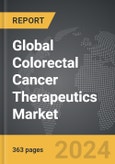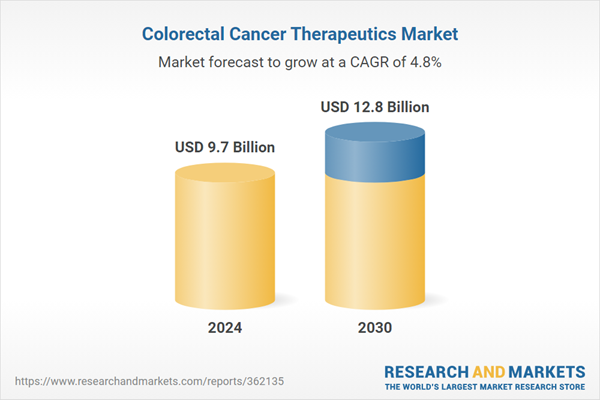Global Colorectal Cancer Therapeutics Market - Key Trends & Drivers Summarized
How Are Therapy Choices Evolving Across The Care Continuum?
Colorectal cancer therapeutics span a modular toolkit that clinicians sequence across disease stages, with chemotherapy remaining the backbone while targeted and immune approaches layer in based on molecular context and treatment history. Foundational cytotoxics such as fluoropyrimidines, oxaliplatin, and irinotecan are deployed as adjuvant or neoadjuvant options around surgery and as first line anchors in advanced disease, then recycled or reconfigured as patients progress. Targeted therapies have reshaped subsets of care by inhibiting angiogenesis or blocking epidermal growth factor signaling in RAS and BRAF wild type tumors, while mutation directed regimens address BRAF or HER2 driven niches and next generation RAS inhibitors move forward in trials. Immunotherapy has shifted outcomes for mismatch repair deficient or microsatellite instability high tumors, with combinations now probing earlier use and perioperative settings, and with parallel studies seeking to sensitize mismatch repair proficient disease using chemotherapy, targeted agents, and novel mechanisms. Alongside these drug classes sit other therapy types that refine local control and long term strategy, including radiofrequency ablation and cryosurgery for limited metastases, radiotherapy for rectal primaries, and increasing use of circulating tumor DNA to guide escalation or de escalation after surgery. This continuous movement from broad cytotoxic pressure to biomarker selected precision reflects an overarching trend toward personalization, where the right mechanism is paired to the right biology at the right moment to preserve operability, deepen responses in the liver, and extend disease control without unacceptable toxicity.Where Do Medicines Move And Who Puts Them In Patients' Hands?
Distribution pathways mirror the clinical complexity of cancer care, with hospital pharmacies at the center because they manage sterile compounding, biologic cold chains, on site safety protocols, and multidisciplinary coordination for infusional regimens. Their formularies carry the breadth of chemotherapy, targeted antibodies, and immune checkpoint agents, and their pharmacists orchestrate dose modifications, supportive care, and drug interaction surveillance during multi agent courses that span cycles and settings. Retail pharmacies are rising in importance as oral agents expand, offering refill logistics, adherence support, and lower friction access that reduce infusion chair time while enabling long term maintenance outside the hospital. This shift is reinforced by telepharmacy counseling and nurse navigator programs that catch early side effects and keep patients on therapy, and by the increasing availability of oral targeted combinations that can be initiated in clinic but maintained at home. Other distribution channels, including specialty pharmacies and integrated delivery networks, knit together prior authorization, copay assistance, and delivery for high cost biologics and targeted combinations, smoothing financial bottlenecks that often disrupt regimen timing. As trials introduce subcutaneous or long acting formulations that compress chair time, channel roles will continue to rebalance, but hospital pharmacies will remain pivotal for new starts, complex combinations, and rapid management of infusion related events, while retail and specialty partners carry the continuity load for chronic oral regimens and supportive medicines.Which Care Settings Shape Utilization And Unlock Access To Innovation?
Hospitals dominate end use because they host tumor boards, surgical suites, radiation facilities, and infusion centers under one roof, allowing rapid transitions between resection, chemoradiation, and systemic therapy that are essential for rectal primaries and oligometastatic disease. These centers also run clinical trials that offer novel combinations and first in class mechanisms, bringing early access to patients and real world experience to staff who later scale new standards across regional networks. Specialty clinics complement hospitals by managing stable maintenance regimens, survivorship needs, and toxicity follow up for patients on oral targeted therapies or immunotherapy, reducing pressure on inpatient resources and improving continuity between cycles. Cancer research centers act as engine rooms for translational science, implementing biomarker workflows that match patients to targeted or immune approaches, piloting circulating tumor DNA surveillance to adjust adjuvant intensity, and testing organ preservation strategies that rely on deep responses rather than default surgery. Together these settings define the practical arc of a patient journey, from diagnosis through lines of therapy and potential resection, and they determine how quickly evidence migrates into routine use, how safely combinations are delivered, and how consistently patients can stay on treatment long enough to capture durable benefit.Why Is Momentum Building And What Specifically Is Powering Demand Right Now?
The growth in the colorectal cancer therapeutics market is driven by several factors that converge across technology, end uses, and purchasing behavior. Expansion of biomarker testing for RAS, BRAF, HER2, and mismatch repair status increases the eligible pool for targeted and immune regimens and encourages companion diagnostic adoption inside hospitals and research centers. Broader use of circulating tumor DNA to guide adjuvant decisions after surgery triggers earlier initiation or rational de escalation of systemic therapy, raising precision and reducing waste. A steady stream of clinical trials evaluating combination strategies across first, second, and later lines fuels clinician confidence and shortens the lag between trial readouts and formulary inclusion. Hospital pharmacies' central role in sterile compounding and biologics handling sustains high uptake of infusional regimens, while growth in oral agents and patient preference for home based continuity shift refills toward retail and specialty channels that improve adherence. Rising awareness and screening, including newer blood based options and renewed colonoscopy throughput, enlarge the diagnosed population at stages where systemic therapy makes the largest impact and where multidisciplinary centers can orchestrate curative intent strategies. Uptake of biosimilars in anti angiogenic and other biologic classes lowers acquisition costs and frees budgets for targeted and immune combinations, improving payer receptivity to optimized sequencing. Finally, next generation mechanisms in development such as direct RAS inhibition, refined anti EGFR strategies, and immunotherapy combinations for mismatch repair proficient disease diversify the future armamentarium, priming hospitals, specialty clinics, and pharmacies to invest in workflows, training, and inventory that support faster adoption without compromising safety or access.Report Scope
The report analyzes the Colorectal Cancer Therapeutics market, presented in terms of market value (USD). The analysis covers the key segments and geographic regions outlined below.- Segments: Therapy Type (Chemotherapy, Targeted Therapy, Immunotherapy, Other Therapy Types); Distribution Channel (Hospital Pharmacies, Retail Pharmacies, Online Distribution Channel); End-User (Hospitals End-User, Specialty Clinics End-User, Cancer Research Centers End-User).
- Geographic Regions/Countries: World; United States; Canada; Japan; China; Europe (France; Germany; Italy; United Kingdom; Spain; Russia; and Rest of Europe); Asia-Pacific (Australia; India; South Korea; and Rest of Asia-Pacific); Latin America (Argentina; Brazil; Mexico; and Rest of Latin America); Middle East (Iran; Israel; Saudi Arabia; United Arab Emirates; and Rest of Middle East); and Africa.
Key Insights:
- Market Growth: Understand the significant growth trajectory of the Chemotherapy segment, which is expected to reach US$6.1 Billion by 2030 with a CAGR of 4.5%. The Targeted Therapy segment is also set to grow at 5.4% CAGR over the analysis period.
- Regional Analysis: Gain insights into the U.S. market, valued at $3.6 Billion in 2024, and China, forecasted to grow at an impressive 6.5% CAGR to reach $1.3 Billion by 2030. Discover growth trends in other key regions, including Japan, Canada, Germany, and the Asia-Pacific.
Why You Should Buy This Report:
- Detailed Market Analysis: Access a thorough analysis of the Global Colorectal Cancer Therapeutics Market, covering all major geographic regions and market segments.
- Competitive Insights: Get an overview of the competitive landscape, including the market presence of major players across different geographies.
- Future Trends and Drivers: Understand the key trends and drivers shaping the future of the Global Colorectal Cancer Therapeutics Market.
- Actionable Insights: Benefit from actionable insights that can help you identify new revenue opportunities and make strategic business decisions.
Key Questions Answered:
- How is the Global Colorectal Cancer Therapeutics Market expected to evolve by 2030?
- What are the main drivers and restraints affecting the market?
- Which market segments will grow the most over the forecast period?
- How will market shares for different regions and segments change by 2030?
- Who are the leading players in the market, and what are their prospects?
Report Features:
- Comprehensive Market Data: Independent analysis of annual sales and market forecasts in US$ Million from 2024 to 2030.
- In-Depth Regional Analysis: Detailed insights into key markets, including the U.S., China, Japan, Canada, Europe, Asia-Pacific, Latin America, Middle East, and Africa.
- Company Profiles: Coverage of players such as Amgen, Inc., Bayer AG, F. Hoffmann-La Roche AG, Merck KGaA, Novartis International AG and more.
- Complimentary Updates: Receive free report updates for one year to keep you informed of the latest market developments.
Some of the 86 companies featured in this Colorectal Cancer Therapeutics market report include:
- Amgen, Inc.
- Bayer AG
- F. Hoffmann-La Roche AG
- Merck KGaA
- Novartis International AG
- Spectrum Pharmaceuticals
This edition integrates the latest global trade and economic shifts into comprehensive market analysis. Key updates include:
- Tariff and Trade Impact: Insights into global tariff negotiations across 180+ countries, with analysis of supply chain turbulence, sourcing disruptions, and geographic realignment. Special focus on 2025 as a pivotal year for trade tensions, including updated perspectives on the Trump-era tariffs.
- Adjusted Forecasts and Analytics: Revised global and regional market forecasts through 2030, incorporating tariff effects, economic uncertainty, and structural changes in globalization. Includes historical analysis from 2015 to 2023.
- Strategic Market Dynamics: Evaluation of revised market prospects, regional outlooks, and key economic indicators such as population and urbanization trends.
- Innovation & Technology Trends: Latest developments in product and process innovation, emerging technologies, and key industry drivers shaping the competitive landscape.
- Competitive Intelligence: Updated global market share estimates for 2025, competitive positioning of major players (Strong/Active/Niche/Trivial), and refined focus on leading global brands and core players.
- Expert Insight & Commentary: Strategic analysis from economists, trade experts, and domain specialists to contextualize market shifts and identify emerging opportunities.
Table of Contents
Companies Mentioned (Partial List)
A selection of companies mentioned in this report includes, but is not limited to:
- Amgen, Inc.
- Bayer AG
- F. Hoffmann-La Roche AG
- Merck KGaA
- Novartis International AG
- Spectrum Pharmaceuticals
Table Information
| Report Attribute | Details |
|---|---|
| No. of Pages | 883 |
| Published | December 2025 |
| Forecast Period | 2024 - 2030 |
| Estimated Market Value ( USD | $ 9.7 Billion |
| Forecasted Market Value ( USD | $ 12.8 Billion |
| Compound Annual Growth Rate | 4.8% |
| Regions Covered | Global |









